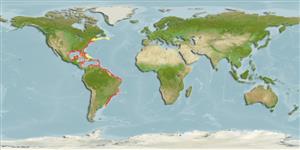>
Carangiformes (Jacks) >
Carangidae (Jacks and pompanos) > Caranginae
Etymology: Trachurus: Greek, trachys, -eia, -ys = rough + Greek, oura = tail (Ref. 45335).
More on author: Nichols.
Environment: milieu / climate zone / depth range / distribution range
Οικολογία
Θαλασσινό(ά) Υφαλόφιλο(α); εύρος βάθους 30 - 200 m (Ref. 5951). Subtropical; 45°N - 37°S
Western Atlantic: Canada (Ref. 5951) to Maine, USA and northern Gulf of Mexico to northern Argentina; apparently rare in the West Indies.
Length at first maturity / Μέγεθος / Βάρος / Age
Maturity: Lm 12.0 range ? - ? cm
Max length : 40.0 cm TL αρσενικό/απροσδιόριστο; (Ref. 7251); common length : 30.0 cm TL αρσενικό/απροσδιόριστο; (Ref. 5217); μεγ. δημοσιευμένο βάρος: 500.00 g (Ref. 5217)
Ραχιαίες άκανθες (συνολικά) : 8; Μαλακές ραχιαίες ακτίνες (συνολικά) : 32; Εδρικές άκανθες: 3; Μαλακές εδρικές ακτίνες: 28. Body elongate and slightly compressed; posterior edge of upper jaw reaching to below anterior margin of eye; eye large with a well developed adipose eyelid; shallow furrow on upper margin of shoulder girdle; body except for small part behind pectoral fin covered with small cycloid scales; body dark blue dorsally, silver-white ventrally; black blotch on posterior margin of opercle; tip of snout dusky; anterior margin and tip of first dorsal fin dusky, other parts pale; second dorsal fin pale; caudal fin dusky, pectoral and pelvic fins pale (Ref. 13608).
Adults are benthopelagic over continental shelves (Ref. 5217). Rare in oceanic insular areas (Ref. 5217). Juveniles associate with the jellyfish Chrysaora lactea in Southwestern Atlantic. Preyed on by juvenile comb grouper (Mycteroperca acutirostris) when protection given by the jellyfish fails (Ref. 52493). Adults are found often in schools. They feed on small invertebrates. Marketed fresh locally and considered a good food fish (Ref. 9626). In southern Brazil, stocks are found in 147 m deep water (Ref. 47377).
Life cycle and mating behavior
Maturities | Αναπαραγωγή | Spawnings | Egg(s) | Fecundities | Προνύμφες
Robins, C.R. and G.C. Ray, 1986. A field guide to Atlantic coast fishes of North America. Houghton Mifflin Company, Boston, U.S.A. 354 p. (Ref. 7251)
IUCN Red List Status (Ref. 130435)
Threat to humans
Harmless
Human uses
αλιεία: Εμπορικό(ά)
Εργαλεία
Special reports
Download XML
Διαδικτυακές πηγές
Estimates based on models
Preferred temperature (Ref.
123201): 9.5 - 27.1, mean 22.5 °C (based on 191 cells).
Phylogenetic diversity index (Ref.
82804): PD
50 = 0.5001 [Uniqueness, from 0.5 = low to 2.0 = high].
Bayesian length-weight: a=0.00933 (0.00831 - 0.01048), b=2.96 (2.93 - 2.99), in cm total length, based on LWR estimates for this species (Ref.
93245).
Τροφικό Επίπεδο (Ref.
69278): 4.0 ±0.2 se; based on diet studies.
Ελαστικότητα (Ref.
120179): Μεσαίο(α), ελάχιστος χρόνος για διπλασιασμό πληθυσμού 1,4 - 4,4 έτη (K=0.16; tm=2).
Prior r = 0.55, 95% CL = 0.36 - 0.83, Based on 1 data-limited stock assessment.
Fishing Vulnerability (Ref.
59153): Moderate vulnerability (37 of 100).
Climate Vulnerability (Ref.
125649): Low vulnerability (11 of 100).
Nutrients (Ref.
124155): Calcium = 110 [48, 194] mg/100g; Iron = 1.94 [1.02, 3.58] mg/100g; Protein = 20.1 [19.1, 20.9] %; Omega3 = 0.201 [0.116, 0.339] g/100g; Selenium = 16.6 [8.3, 34.4] μg/100g; VitaminA = 63.7 [15.9, 264.8] μg/100g; Zinc = 1.65 [1.07, 2.55] mg/100g (wet weight); based on
nutrient studies.
